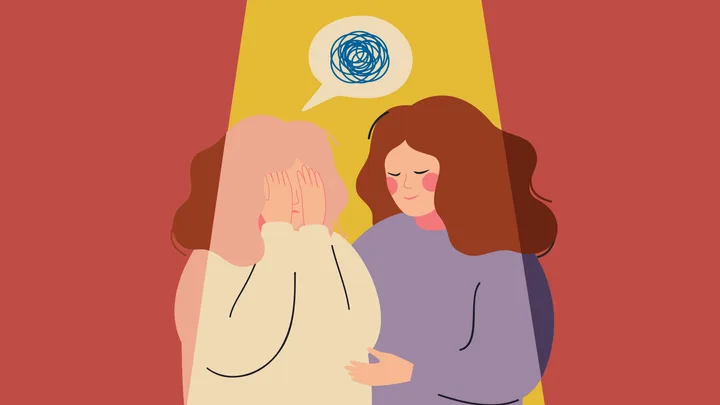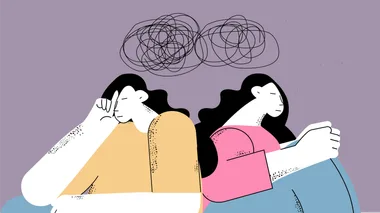This article touches on the topics of anxiety and depression which may be triggering for some readers.
Anxiety has become a global health pandemic and the world is desperate for a cure. But, a new wave of psychotherapists believe a dose of good, old-fashioned compassion might be the best way of dealing with anxiety.
The World Health Organisation has estimated anxiety and depression will be the number one health concern globally within a decade. They’re debilitating conditions that suck the joy from life, and even kill. However, the key to managing anxiety might lie in a motivating force that exists alongside them in the human brain.
Professor Paul Gilbert OBE, the instigator of compassion-focused therapy, champions the power of kindness as the answer to the age-old of question of how to reduce anxiety. It’s not a panacea, he admits, but it’s one of the most effective tools we have to deal with anxiety and depression. The human impulse for kindness and compassion can be directed within to heal ourselves and beyond, to heal the world.
Take Joanne for example. She has spent her whole life dealing with a persistent and irrational “inner critic” who sabotaged her every joy and victory for so many years.
“In my early 30s, I went back to university. I couldn’t believe that I could finally complete a Master’s degree in psychology degree,” she says. “But I did all that, and I did it across three universities as we moved with my husband’s job, while having two children. It was very stressful. Yet all the while this inner critic was telling me I was lazy and good-for-nothing and everyone around me was doing so much better.”
Her “light-bulb moment” in terms of how to deal with her anxiety came a full 20 years later. Paul Gilbert was in Australia for a series of lectures, and on a whim, Joanne went along. “We did a simple compassion-focused therapy exercise, which is to imagine what that critical voice sounds like and what it is saying. Mine was fairly caustic,” she recalls.
“There were about 200 therapists in the room and Paul asked some of them to describe their inner voice, and people were saying things like ‘mine’s quite harsh’ or ‘mine doesn’t say much at all’. But my immediate thought was that mine was telling me the truth. I really believed that. So I put my hand up and said, ‘What if it’s the truth?’ I felt like a complete idiot saying it. But afterwards, at the tea break, Paul found me in the crowd and said, ‘You know, that voice is not the truth’. And that just seeded enough doubt in my mind that I was prepared to look further. It got me asking, What if he’s right?’ And I began to recognise how much pain and suffering that voice had caused me.
“Overnight I developed a completely different relationship to that critical voice, and I realised compassion can be for the self as well as for others.”

The science of compassion therapy
Paul Gilbert is based at the University of Derby in England but he returns to Australia often, working with the University of Oueensland, where researchers are studying the efficacy of compassion-focused therapy in treating weight issues and eating disorders.
He explains why critical inner voices, such as Joanne’s, are so common and how they can be overcome.
“It’s not our fault,” he begins earnestlv. “You have two arms and two legs, blue eyes and brown hair because these things have been built for you. Your brain has also been built for you, and all the things that go on in your brain – fear, anger, anxiety have been built into it by evolution, your genes and background. Many of our most difficult emotions are rooted in the systems in our brain that have evolved over millions of years.’
“What we see now is quite a problematic increase in anxiety and depression,” Joanne adds. “But if we look at what type of design the brain has, that isn’t very surprising. The brain has evolved to respond to threat, to keep us safe, to ensure we’re always ready to defend ourselves. So we are walking around constantly monitoring and scanning for threats and that was very useful in the wilderness.
“The trouble is that now, in the 21st century, we’re living in this fast-paced world, overloading our senses, and things we can perceive as threats are coming at us 24/7. It never stops. We can make that choice between kindness and cruelty.’ So we’re perpetually on high alert and that creates anxiety.”
We haven’t chosen to be hard-wired with knee-jerk reactions to protect ourselves when we feel threatened. Nor have we chosen most of the formative experiences in our lives that mould us.
“We don’t choose the way our brains have developed, whether through loving kindness or trauma” Paul says. “We shouldn’t blame ourselves, but once we’re aware of it, it’s our responsibility to take control, because if we don’t, the results can be harmful to ourselves and others. Fortuitously, although evolution has laid down basic systems in our brains through which aggression, anxiety and fear can flourish, it has also made possible our disposition for compassion. And we have the power to choose compassion.
“As a species, I think we’re all capable of great kindness and great cruelty,” Joanne explains. “We can make that choice between kindness and cruelty. Each one of us has that responsibility and capacity within us.”

How to help relieve anxiety with compassion
Compassion therapy has been influenced by a combination of evolutionary theory, clinical psychology and Buddhism. And in the context Paul uses it, compassion feels as much like a verb as a noun. There’s movement in it. He often refers to the Dalai Lama’s definition: “a sensitivity to the suffering of self and others, with a deep wish and commitment to relieve that suffering.”
So, the first step when it comes to answering the question of how to deal with anxiety is to become aware of the suffering – one’s own or someone else’s – and the second step is to try to alleviate it. The Irish counsellor and author, Padraig O’Morain, coined the term ‘kindfulness’ to describe this ephemeral mix of a way of thinking and a way of being in the world.
A mountain of scientific evidence tells us that if we can become kinder, more compassionate people, we will be happier, and that happiness will ripple out into the world around us. Compassion has been found to reduce blood pressure, anxiety, symptoms of PTSD and depression, to improve sleep and boost serotonin. “If you want others to be happy, practise compassion,” says the Dalai Lama. “If you want to be happy, practise compassion.”
So, how do we flick the switch? Next time we feel threatened or insecure, how do we quiet the voice that judges and condemns, and apply compassion?
“Like everything, it takes practice,” says Joanne about how to deal with anxiety through self-compassion.

Practicing compassion towards oneself
First, we need to understand that the emotional tone we use can either increase our sense of threat, and with it our levels and stress and anxiety, or decrease it. We can choose to go into battle, or not. So, Joanne suggests we begin by really listening to and observing our inner critic. “You have to know how you are triggering your threat system with your own internal messages,” she says, “and acknowledge the feelings that come with it.” Then we can begin to develop a more compassionate voice.
“That gentle, wise voice might not be something you can see coming from yourself initially,” says Joanne, so she often asks her clients to imagine a calm, helpful, caring friend. “What would they say? How would they say it? What would they look like? What qualities would they have? You might imagine Christ or Buddha or your grandmother or Oprah Winfrey, or you might create someone completely imaginary who will just sit with you, understand you and give you a hug.”
Joanne also uses meditation and conscious breathing to activate the parasympathetic nervous system, which is the gentle, collaborative, social part of our brain and emotional system, and which helps us to calm our breathing and heart rate, lower our levels of cortisol and adrenaline, and reduce that hypervigilant response to threat.
Finally, she says, we need to maintain motivation and keep practising. “When you feel anxious or threatened, remember your slow, deep breathing, and respond to that vicious, judgmental aspect of yourself in a way that’s more accepting, understanding and comforting. If you can do that, it will soothe your anxiety and you will be able to think through problems more calmly and clearly.”
Life still throws Joanne the occasional curveball. The difference now is that she doesn’t beat herself up about it.
“Difficult things are still going to happen; you’re still going to feel hurt by life. But knowing how to be more helpful to yourself when you’re suffering makes a world of difference.”
If this article causes concern, help is available at Lifeline, phone 13 11 14, and Beyond Blue. For more about compassion-focused therapy, visit compassionatemind.org.au.










